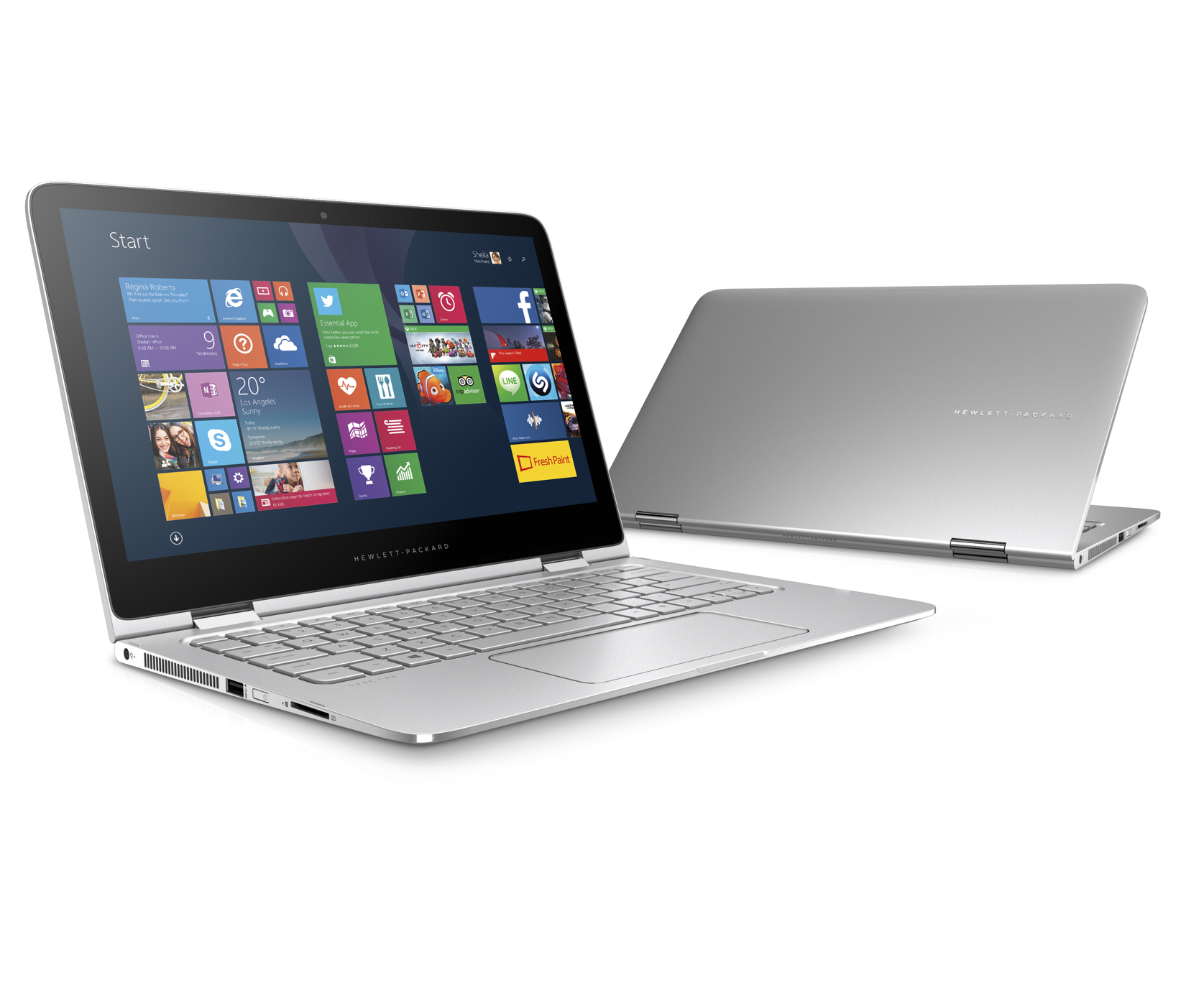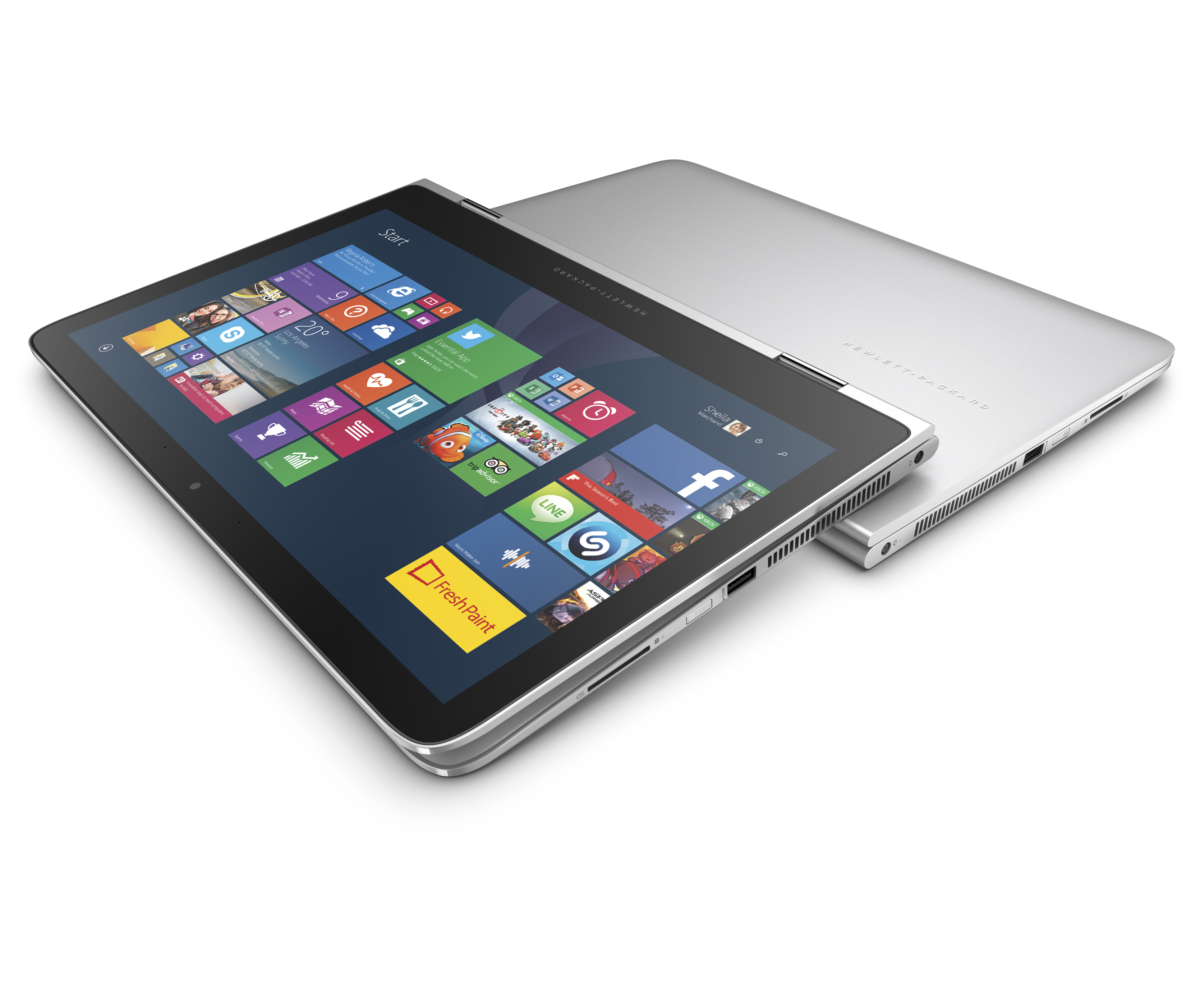HP Takes Aim At Apple, Lenovo With Spectre x360 Multimode Ultrabook
Make no mistake, HP's latest ultrabook, the HP Spectre x360, is a direct attempt to compete with Apple's MacBook Pro line, as well as Lenovo's attractive Yoga Pro series of multimode laptops.
An HP representative basically said as much when he briefed us on the new device, and he spent the majority of our time extolling the virtues of the Spectre x360's precise, determined, and high-end design and build quality (take that, MacBook) as well as its expertly-engineered and -crafted hinge (how do you like them apples, Lenovo).
High-End Design
The 13.3-inch Spectre x360 has a CNC-machined aluminum chassis that HP said both enhances rigidity and allows it to precisely cut the metal such that a 56 WHr battery would fit inside with precision. The outside edge has a polished cut. The touch panel is optically bonded to the display, which HP claimed increases brightness by "pulling each pixel up to the surface of the display."
HP wanted this device to be as thin and light as possible, and the resulting product weighs as little as 3.17 lbs (anything under 3.5 lbs seemed "light" to customers, according to HP's research) and measures 0.63 inches at it thickest point.
The keyboard and touchpad got plenty of attention from the HP team. HP said that it felt strongly about delivering a full-size (well, tenkeyless) keyboard with nice key travel (this one offers 1.5 mm of travel), "good response on the bottom of key event," and satisfying feedback on the "dish" of the keyboard. The touchpad is an extra-wide Control Zone, which HP has used on its ultrabooks and purports to offer high palm rejection.
The Wi-Fi performance alleges to be superb. HP said that the CNC-machined chassis allowed it to place the antenna near the top of the display (with no cover to blemish the unibody look), and the company claims that its performance, at both 2.4 GHz and 5 GHz, is specially tuned to work better than the competition in "noisy" networks and a variety of access points, with less signal degradation over distance.
The Specs
HP hardly mentioned the Spectre x360's specs when we spoke, but they're quite solid on paper. Here is what’s inside the base model (Spectre x360 13t):
Get Tom's Hardware's best news and in-depth reviews, straight to your inbox.
| Header Cell - Column 0 | HP Spectre x360 13t |
|---|---|
| CPU: | 5th generation Intel Core i5-5200U |
| GPU: | Intel HD graphics 5500 |
| Memory: | 8 GB 1600 MHz LPDDR3 SDRAM |
| Storage: | 256 GB SSD |
| Display: | 13.3-inch Full HD(33) Infinity LED-backlit touchscreen |
| Keyboard: | Full-size island-style backlit keyboardHP Imagepad, multitouch |
| Ports: | -3 SuperSpeed USB 3.0-1 Mini DisplayPort-1 HDMI-1 Headphone-out/microphone-in combo jack-Multi-Format Digital Media Card Reader |
| Connectivity: | 2x2 802.11ac WLAN and Bluetooth |
| Other: | -HD Audio with stereo speakers-Front-facing HP TrueVision Full HD WVA webcam with integrated dualdigital microphones |
| Dimensions: | 12.79 in (W) x 8.6 in (D) x 0.6 in (min H)/0.63 in (max H) |
| Weight: | 3.26 lb |
| Battery: | 3-cell 56 WHr 4.96 Ah lithium-ion battery, 12.5 hrs |
| Price: | $899 |
Another SKU offers an Intel Core i7 chip and 8 GB of RAM along with the Full HD touchscreen display and 256 GB SSD ($1,149.99). From there, the highest-end device in the lineup brings a Quad HD IPS display and 512 GB of RAM to the table for $1,399.99. HP said that the Quad HD display's Panel Self Refresh (PSR) aids battery life, because it "holds images on the screen to allow portions of the PC to power down when nothing on-screen is moving."
HP told us that a fourth, high-end model would be coming in April, as well.
A notable aspect of some of the Spectre x360 laptops is the fact that they have full-size ports, including full-size HDMI and DisplayPort 1.2 ports. There's also WiDi and three USB 3.0 ports, all three of which offer the ability to charge other devices even in sleep mode. The entry-level model appears to swap the full-size DisplayPort for a mini version.
Other features include HD Audio with stereo speakers, a media card reader and front-facing HP TrueVision Full HD webcam.
According to the specifications, the Spectre x360 devices purport to offer 12.5 hours of juice. At least, that was the case on a pre-production version of the entry-level model, which was tested with MobileMark 12 and had half the memory (4 GB LPDDR3 instead of 8 GB) and SSD capacity (128 GB instead of 256 GB). HP let slip that battery life might actually be closer to 10 hours.
The Hinge
Although the 2-in-1 form factor is attractive in some ways, HP did not want the Spectre x360 to be one. The team didn't want a keyboard that would slide off when it was bumping around inside your bag, nor an attachable, click-on keyboard that could be clunky. That's why the Spectre x360 is instead a multimode notebook. Of course with a multimode device, so much, er, hinges on the hinge.
This hinge is designed to be as thin in laptop mode as it is in clamshell mode, and it will be "out of the way" in tablet mode. It's a geared mechanism with a dual-cam hinge; it syncs the gears together so that the inner hinge folds onto itself.
Thus, the Spectre x360 should retain a sleek look whether you're using it as a laptop, as a tablet, in tent mode, or with the screen propped up and the keyboard folded under.
Availability begins today from HP, and you can find Spectre x360s at Best Buy stores starting tomorrow.
Follow Seth Colaner @SethColaner. Follow us @tomshardware, on Facebook and on Google+
Seth Colaner previously served as News Director at Tom's Hardware. He covered technology news, focusing on keyboards, virtual reality, and wearables.
-
CaedenV Dear HP,Reply
I appreciate that you are no longer making craptastic laptops with bulkey polkadotted plastic anymore. Surely firing whoever thought that was a good idea was a good move. However, Windows runs just fine on Apple products. Almost all of my professors at school run Windows on their MBPs, all of my designer friends run Windows on their MBPs, and quite literally anyone who wanted a high-end Windows laptop up until ~2 years ago simply purchased a MBP... But contrary to what this seems like, it does not mean that people want MBP devices, it just means that they have not had any other options available to them. In fact, making a MBP clone will not help because those who want a MBP are going to simply buy a MBP and get the excelent hardware support and service that HP will never provide their customers.
But now we have the Acer S7 and Dell XPS13, and those are selling very well simply because they are not MBPs, they are unique, beautiful, powerful machines. Please take a page from their book and have some amount of leadership in the design of your own hardware rather than making crap or clones of other devices. -
IzzyCraft It's not a macbook pro clone it's a clone of Dell's inspiron 7000 13" 2-in-1 laptop spec wise and looks wise which Dell copies macbook pro for looks.Reply -
Blazer1985 Humm MBP as an high end windows pc? The impossibility of using Optimus (not sure if this issue is still present) killed their battery life under Windows. Thermal constraints made them throttle while toasting your thighs at >50c. Glossy screen the only option. Imho these can not be considered pro anymore, since a long time.Reply -
getochkn "the highest-end device in the lineup brings a Quad HD IPS display and 512 GB of RAM to the table for $1,399.99. "Reply
don't you mean 512GB storage?? Otherwise 512GB ram is a steal at that price, and I'd love to see the density of those chips used and the chipset. -
kawininjazx But it's still an hp. once this goes out of warranty you are boned on fixing this.Reply -
d_kuhn While I still have a 17" HP for when I need it (Extreme series i7, 32gb, ssd, 4GB high performance graphics, dreamcolor)... my daily driver is a loaded rMBP, which is only half a step behind the high end HP systems and was quite a bit less expensive... and is about half the weight and half the size (the 17" Zbook is a back wrecker).Reply -
Awakendabeast Help hp spectre x360 or macbook pro 13inch 2014 model or 2015? i just want a beast of a laptop...Reply



